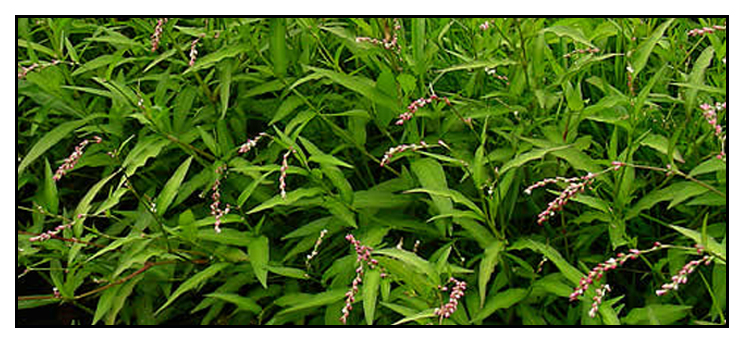 Gen info Gen info
• Persicaria is a genus of herbaceous flowering plants in the knotweed family, Polygonaceae. Plants in the genus are commonly known as knotweeds or smartweeds. It has a cosmopolitan distribution, with species occurring worldwide.
Botany
• Buding is a smooth, rather robust annual, with tufted or shortly creeping roots. Stems are erect, while the branches are ascending, rather stout and leafy, 30 to 45 centimeters high, often glandular. Nodes are often swollen. Leaves are lanceolate or oblong-lanceolate, up to 7.5 centimeters long. Racemes are flexuous, leafy at the base, threadlike, decurved and interrupted. Flowers are pinkish. Nuts are usually three-sided.
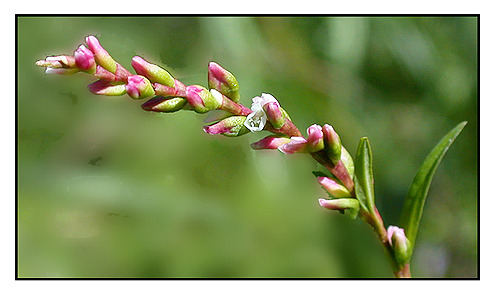 • Water pepper is an annual herb with an erect stem growing to a height of 20 to 70 cm (8 to 28 in). The leaves are alternate and almost stalkless. The leaf blades are narrowly ovate and have entire margins fringed by very short hairs. They are tapering with a blunt apex. Each leaf base has stipules which are fused into a stem-enclosing sheath that is loose and fringed at the upper end. The inflorescence is a nodding spike. The perianth of each tiny flower consists of four or five segments, united near its green base and white or pink at the edges. There are six stamens, three fused carpels and three styles. The fruit is a dark brown oval, flattened nut. (32) • Water pepper is an annual herb with an erect stem growing to a height of 20 to 70 cm (8 to 28 in). The leaves are alternate and almost stalkless. The leaf blades are narrowly ovate and have entire margins fringed by very short hairs. They are tapering with a blunt apex. Each leaf base has stipules which are fused into a stem-enclosing sheath that is loose and fringed at the upper end. The inflorescence is a nodding spike. The perianth of each tiny flower consists of four or five segments, united near its green base and white or pink at the edges. There are six stamens, three fused carpels and three styles. The fruit is a dark brown oval, flattened nut. (32)
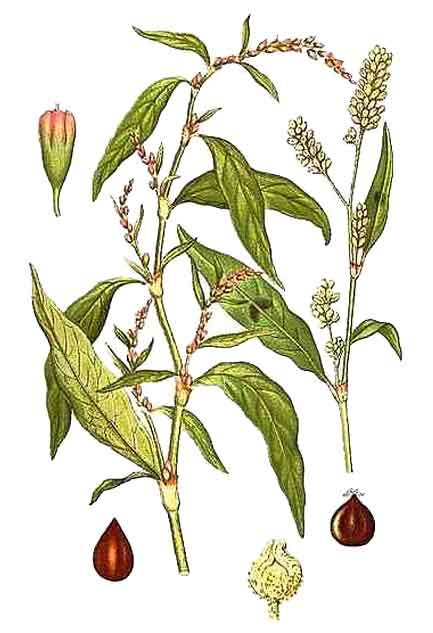 Distribution Distribution
- Native to the Philippines.
-
In the Benguet Province of Luzon, in open wet places, along streams, in old rice paddies, etc., at altitudes of 1,200 to 2000 meters.
- Occurs in warmer parts of the world.
- Also native to Afghanistan, Albania, Algeria, Altay, Amur, Andaman Is., Assam, Austria, Azores, Baltic States, Bangladesh, Belarus, Belgium, Bulgaria, Buryatiya, Central European Russia, China South-Central, China Southeast, Chita, Corse, Czechia-Slovakia, Denmark, East European Russia, East Himalaya, Finland, France, Germany, Great Britain, Greece, Hainan, Hungary, India, Inner Mongolia, Iran, Ireland, Irkutsk, Italy, Japan, Jawa, Kazakhstan, Khabarovsk, Kirgizstan, Korea, Krasnoyarsk, Krym, Kuril Is., Madeira, Malaya, Manchuria, Mongolia, Morocco, Myanmar, Nansei-shoto, Nepal, Netherlands, New South Wales, Nicobar Is., North Caucasus, North European Russia, Northwest European Russia, Norway, NW. Balkan Pen., Ogasawara-shoto, Pakistan, Poland, Portugal, Primorye, Qinghai, Queensland, Romania, Sakhalin, Sardegna, Sicilia, South Australia, South European Russia, Spain, Sri Lanka, Sumatera, Sweden, Switzerland, Tadzhikistan, Taiwan, Tasmania, Thailand, Tibet, Transcaucasus, Tuva, Türkey, Türkey-in-Europe, Ukraine, Uzbekistan, Victoria, Vietnam, West Himalaya, West Siberia, Western Australia, Xinjiang, Yakutiya. (30)
Constituents
- Seed contains polygonic acid and tannin.
- Leaves contain an essential oil, malic acid and phytosterine.
- Rootstock yield an essential oil, oxymethyl-anthraquinone.
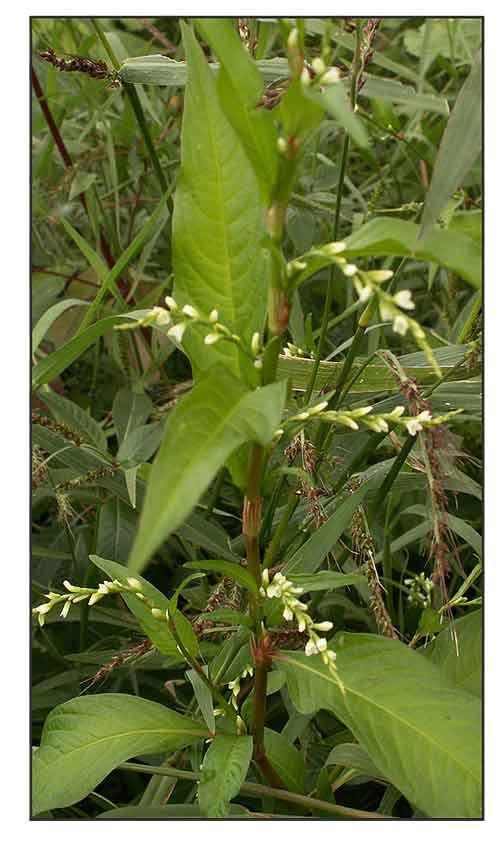 - Screening of ethanol extract yielded alkaloids, flavonoids, saponins, tannins, terpenoids, and steroids.
(see study below) (20) - Screening of ethanol extract yielded alkaloids, flavonoids, saponins, tannins, terpenoids, and steroids.
(see study below) (20)
- Leaves yield 7.5% protein, 1.9% fat, 8% carbohydrate, 2% ash. Also contains rutin.
- Study of whole plant yielded one new drimane-type sesquiterpenoid, 3 β-angeloyloxy-7-epifutronolide (1), and one new natural product, polygonumate (2), along with six known drimane-type sesquiterpenes-- [dendocarbin L, (+) winterin, (+) fuegin, changweikangic acid A, futronolide, and 7-ketoisodrimenin. (14)
- Various extracts and fractions yielded flavonoids such as (+)-catechin, (−)-epicatechin, hyperin, and isoquercitrin; isorhamnetin, kaempferol, quercetin, quercitrin, rhamnazin and rutin; drimane-typed sesquiterpenes, such as 3-β-angeloyloxy-7-epifutronolide, 7-ketoisodrimenin, changweikangic acid A, dendocarbin L, (+)-fuegin, futronolide, polygonumate, and (+)-winterin; phenylpropanoid esters, including hydropiperosides A and B, and vanicosides A, B and E; and phenolic acids, such as caffeic acid, chlorogenic acid and ρ-coumaric acid. (16)
- Preliminary phytochemical screening of acetone, methanol, and aqueous extracts of leaves showed presence of phenols, tannins., flavonoids, glycosides, terpenoids, and alkaloids. (37)
- GC-MS assay of methanol extract of leaves identified 54 phytocompounds, including 7 major compounds
including Andrographolide, 1H-cyclopropa[a] naphthalene, 1a,2,3,5.6,7a7b-octahydro-1,1,7,7a-tetramethyl-[1aR-(1a?,7?,7a?,7b?)-, Cis-Z alpha bisabolene epoxide, 1,8-cyclopentadecadiyne, Aromadendrene oxide (2), Bicyclo[4.1.0]heptane-3-cyclopropyl 7-hydroxymethyl, (cis) and Alpha-guanine. (37)
- Study of ethanolic extract yielded major components of chlorogenic acid, ferulic acid, rutin, myricetin, and quercetin, while the essential oil yielded dodecanal, caryophyllene, caryophyllene oxide, decanal,
α-caryophyllene, citronellol, heptadecanal, linalool, and phytol. (see study below) (40)
Properties
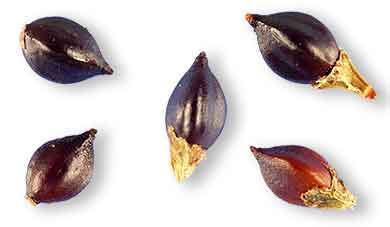 - Considered anti-inflammatory, astringent, carminative, contraceptive, diaphoretic, diuretic, emmenagogue, stimulant, stomachic, styptic. - Considered anti-inflammatory, astringent, carminative, contraceptive, diaphoretic, diuretic, emmenagogue, stimulant, stomachic, styptic.
-
Juice considered diuretic, carminative and anthelmintic.
- Root is bitter, tonic, and stimulating.
- Studies have suggested antioxidant, antibacterial, antifungal, anthelmintic, cytotoxic, anti-inflammatory, antinociceptive, len aldose reductase inhibitory, antifertility, insecticidal, tyrosinase inhibitory, anti-obesity, neuroprotective, antihypertensive, antinociceptive, antidiarrheal, phytoremediative, α-amylase and α-glucosidase inhibitory, hepatoprotective properties.
Parts used
- All plant parts.
Uses
Edibility
- Leaves and stems are edible, raw or cooked.
- Leaves used as veggie-addition to soups, stews, and salads.
- Young shoots used in savory pies.
- Seeds
made into a peppery condiment as substitute for pepper.
-
Young seeds used as salad garnish.
- In Japan, young shoots used as spice and garnish with raw fish (sashimi). (16)
- Water or ethanol extracts used as food additive to preserve pickles, dressing and cooked food. (16)
- Tade-zu is a water pepper sauce, traditionally made from finely chopper water pepper leaves, soaked in vinegar, and a small amount of steamed rice. Occasionally, juice from a squeezed kabosu (citrus fruit if evergreen broad-leaf tree) is added. (32)
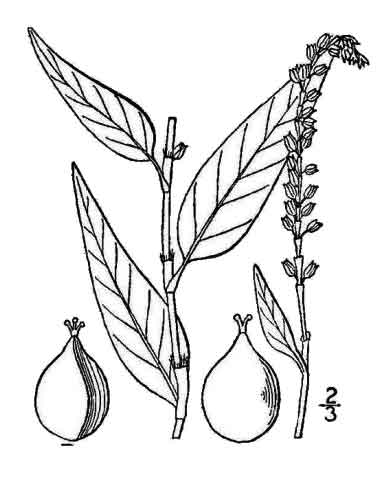 Folkloric Folkloric
- In China, juice is used for itches; also as diuretic, carminative and anthelmintic.
- Root used as tonic and stimulant.
- Decoction of whole plant used for diarrhea, dyspepsia, hemorrhoids, and excessive menstrual bleeding.
- Bruised leaves used as poultice and cure for toothache.
- Used to regulate menstrual irregularities.
- Used for treatment of obesity.
- Among Russian peasant, used as hemostatic.
- Used in all cases of intestinal hemorrhage (pulmonary, gastric, hemorrhoidal, uterine) and used as sedative.
- In the United States, once used as an emmenagogue.
- In Assam, women used the roots for fertility control: Dried root powder used for termination of pregnancy; continuous use for more than a year reported to cause permanent sterility. (16)
- In Bangladesh, leaf juice used for menstrual pain and leaf paste to stop bleeding. (16) Used for the treatment of insomnia, depression and neurodegenerative illnesses. (27)
- In Vietnam, stems and leaves used for snake bites; also as diuretic and anthelmintic. (16)
- In Bangladesh, leaves used to treat rheumatic pain, gout, skin diseases (scabies, ringworm), abscesses, snake, dog, and insect bites. (17) Juice of leaves used for headaches, pain, toothache, liver enlargement, gastric ulcers, dysentery, dysmenorrhea and loss of appetite. (24)
- In Malaysia, decoction consumed to heal stomach ache; also used to treat dandruff. (20)
- In the Himalayas, leaf juice used in uterine disorders. The tribal people of Tripura and Bangladesh use the plant to treat headaches: the leaves are crushed with ten black peppers and taken through the nose. In Assam, leaf juice used for pains. Leaf extract applied externally to scabies. (29)
Others
- Dye: Yields a yellow dye used as traditional fabric dye. (29)
- Repellent: Dried plants used as insect repellent and to protect clothes. Leaf extract is sprayed against crop pests. (29) Juice used to keep flies off livestock injury.
- Fish poison: Used to stupefy fish. (29)
- Veterinary: P. hydropiper is used to treat diarrhea and dysentery in livestock or poultry. Used for treatment of uterine bleeding and intestinal parasites in animals. (see study below) (41)
Studies
• Hydropiperoside / Antifertility Activity: Study of methanol extract yielded a novel coumaryl glycoside, hydropiperoside, with other known compounds and an unidentified lactone possessing antifertility activity. (1)
• Antioxidant Flavonoids: Study isolated ten flavonoid compounds from the dried leaves of P. hydropiper. The isolated flavonoids were shown to possess strong antioxidative capabilities. The most powerful was galloyl quercitrin. (2) Study showed good antioxidant activity on ORAC assay. (20)
• Antibacterial / Antifungal: Study of root extract showed significant antibacterial activities against four gram-positive (B subtilis, B megaterium, S aureus and E aerogenes) and four gram-negative (E coli, P aeruginosa, S typhi and S sonnei) bacteria, with antifungal activity against A fumigatus, A niger, A flavus, C albicans, Rizopus oryzae and T rubrum. (3)
• Lens Aldose Reductase Inhibition: Sulfated flavonoids in Polygonum hydropiper showed potent inhibition against lens aldose reductase. Among the flavonoids, the most potent was isorhamnetin 3,7-disulfate. (4)
• Antifertility / Roots: Study of the methanolic extract of root showed anti-fertility activity in female albino rats. The estrous cycle of the extract treated rats became irregular resulting in failure of gestation. Results suggest the root of PH contains steroidal / estrogenic compounds which affect female reproduction in rats. (6)
• Insecticidal: Study of 5 kinds of Polygonum hydropiper organic solvent extracts showed the ethyl ether extract to have the strongest insecticidal effect. The insecticidal substance was identified as eugenol. Eugenol showed to have stomach toxicity and contact action; it suppressed AchE and GST activity. (7)
• Tyrosinase Activity Inhibitor: Study isolated taxifolin, a tyrosinase inhibitor from the sprout of Polygonum hydropiper. Compared to cosmetic agents arbutin and kojic acid, taxifolin's tyrosinase inhibitory effect was equal to the latter, more than the former. (8)
• Cytotoxic Activity: Study showed cytotoxic activity, yielding cytotoxic compounds soluble in both water and ethanol. Results suggest a therapeutic potential in antitumor therapy. (11)
• Estradiol-like Effects: In a study of crude extract of roots , P. hydropiper mimics the effect of estradiol-17ß in the uterine protein profiles of adult female albino rats. (12)
• Anti-Inflammatory Effects: Study of methanol extract of Polygonum hydropiper showed strong anti-inflammatory activity. There was dose-dependent suppression of release of nitric oxide (NO), tumor necrosis factor (TNF)-a, and prostaglandin (PGE2) IN RAW264.7 cells and peritoneal macrophages stimulated by lipopolysaccharide. (13)
• Phytoremediation / Nitrogen and Phosphorus: Study showed the mining ecotype (ME) of P. hydropiper removed as high as 87.47% of total nitrogen and 97.63% of total phosphorus. Results show a theoretical basis for use of P. hydropiper for N and P removal from livestock wastewater and presents as a promising species for the phytoremediation of eutrophic waters. (15)
• Antinociceptive / Leaves: Study evaluated the antinociceptive activity of methanol extract of leaves in both heat- and chemical induced pain models in mice. Results showed significant antinociceptive activity with both central and peripheral mechanisms. Pretreatment with naloxone significantly reversed the antinociceptive produced by the MEPH suggesting involvement of the opioid system. (17)
• Antimicrobial / Insecticidal: Crude extracts of P. persicaria showed significant activity against E. coli. A leaf extract showed significant activity against A. niger and moderate activity against A. flavus, H. maydis, and A. solani. It showed insecticidal activity against T. castaneum, S. oryzae, R. dominica and C. analis. (18)
• Anthelmintic / Antiproliferative / Aerial Parts: Study evaluated aerial parts of Persicaria hydropiper for anthelmintic and antiproliferative activity. Results showed in vitro anthelmintic activity against Pheretima posthuma. Study also showed in vivo antiproliferative activity against Ehrlich Ascites Carcinoma with significant (P>0.05) decrease in tumor weight, increase life span, and reduced tumor cell growth. (19)
• Anti-Obesity / Quercetrin / Inhibition of Differentiation of Adipocyte 3T3-L1 Cells: Evidence suggests Wnt/ß-catenin pathway can potentially control adipogenesis related to obesity. Study screened eleven plant extracts activating the Wnt/ß-catenin signaling reporter gene. Study showed the isoquercitrin in P. hydropiper suppresses the adipogenesis of 3T3-L1 cells via inhibition of Wnt/ß-catenin signaling. P. hydropiper and isoquercetrin may have potential as therapeutic agents for obesity and its associated disorders. (22)
• Insect Deterrent Drimanes / Drimenol Synthase and Drimenol Oxidase / Cinnamolide: Study isolated a drimenol synthase (PhDS) and a cytochrome P45) drimenol oxidase (PhDOX1) from P. hydropiper. In agro-infiltration in Nicotiana bethamiana leaves, drimenol was converted into cinnamoide and other drimenol derivatives. In vitro assays showed conversion from drimenol to drimendiol which was further oxidized and converted to cinnamolide. Purified cinnamolide was showed to be an effective deterrent against both whitefies and aphids with ED50 of about 200-400 µg g-1 fresh weight. (23)
• Antioxidant / Antibacterial: In a study of five Malaysian herbal extracts,P. hydropiper showed high antioxidant and antibacterial activities. It showed the highest antioxidant activities in FRAP and ORAC assays with 1676.67 mM TE/g EW and 11.20 mmol TE/g EW, respectively. (see constituents above) (20)
• Antihyperglycemic / Antinociceptive / Leaves: Study of various doses of ethanolic leaf extract of P. hydropiper in glucose-loaded mice showed significant reduction of blood glucose levels by 48.8% to 52.2% (p<0.05) compared to standard glibenclamide with 42.1% reduction. In antinociceptive activity testing, there was reduction of abdominal writhings by 14.10 to 41.02% compared to standard drug Aspirin. Brine shrimp naupili toxicity testing showed LC50 of 16.22 µg/ml, compared to control. (24)
• Xanthine Oxidase Inhibitory Activity / Antioxidant: Study evaluated methanol extract fractions for total phenolic content and antioxidant activity by DPPH, ferric thiocyanate and XO inhibition assays. Butanol and EA fractions showed higher phenolic content of 224.38 and 68.95 mg GAE/100g dry extract, respectively. Both showed DPPH radical scavenging activity with IC50 of 28.61 and 25.55 µg/ml. Both fractions inhibited xanthine oxidase activity with IC50 of 28.72 and 165.25 µg/ml. (25)
• Antimicrobial / Weak Antimalarial Activity: Study of two crude extract and two fractions from Polygonum hydropiper was evaluated for antimicrobial and antimalaria activity. Results showed weak antimalarial activity. Antimicrobial testing showed activity against Aspergillus fumigatus and mild activity against K pneumoniae, E. coli and C. neoformans. (26)
• Sedative and Anxiolytic / Leaves: Study of methanol extract of leaves of Persicaria hydropiper in mice showed sedative and anxiolytic effects. Sedative effect was evaluated using open field hole cross, rota rod and thiopental sodium-induced sleeping time , while anxiolytic activity was evaluated using elevated plus maze, light-dark box, hole board and marble burying test. (27)
• Larvicidal against Ae. aegypti / Dengue Fever Vector: The larvicidal efficacy of nine medicinal plants collected from Western Ghats, india, was assessed against fourth instar larvae of Aedes aegypti. The larvicidal assay was done according to WHO standard protocol with acetone, methanol, petroleum ether, and water extracts. Two of nine, Persicaria hydropiper and Plectranthus hadienses showed significant larvicidal efficacy with LC50s of 489.278 Mg/L and 414.746 Mg/L, respectively, against 4th instar larvae of the dengue fever vector. Results suggest the plants has potential as a natural insecticide for mosquito control programs. (28)
• Antihypertensive / Suppression of Salt-Infuced Hypertension / Leaves: A novel chymase inhibitor has been reported to have a deprssor effect in salt-induced hypertension. Study evaluated the hypothesis that chymase inhibitory dried young leaves or young leaves extract of Polygonum hydropiper could reduced salt-induced hypertension. Powdered young leaves at maximum dose of 500 mg/kg produced remarkable suppression of high blood pressure. Young leaves extract at maximum dose of 20 mg/kg showed greater suppression of high blood pressure. (33)
• Cestocidal / Anthelmintic / Leaves: Persicaria hydropiper is used by the Naga people of India for treatment of helminth infections. Study evaluated the invitro anthelmintic efficacy of methanol extract of P. hydropiper leaves using measures of paralysis and mortality on Raillietina echinobothrida, an intestinal cestode parasite of domestic fowl. In vitro results showed dose-dependent efficacy. Observations revealed notable impairment in scolex, distorted suckers and eroded spines, amd shrunken tegument with impaired microtriches. Results showed noteworthy anthelmintic efficacy and justify its use in traditional medicine against intestinal worms. (35)
• Topical Gel Formulation for Wound Healing / Leaves: Study evaluated herbal gel formulations incorporating P. hydropiper leaves for potential therapeutic applications. Gels were characterized for pH, viscosity, spreadability, net content, extrudability, and physical appearance. Most formulations adhered to the Zero Order model indicating controlled and consistent drug release. Formulations demonstrated significant lipid peroxidation inhibition indicating strong antioxidant activity. COX-1 and COX-2 inhibition studies highlighted its anti-inflammatory potential, with IC50s of 180.271 and 188.361 µg/mL, respectively. TFC was 321.44 mg/g QE. Findings suggest potential of PHLE-MA-based gel formulations as effective topical agents with antioxidant and anti-inflammatory properties. (36)
• Antinociceptive / Antidiarrheal / Leaves: Study evaluated methanol leaf extracts of Persicaria hydropiper for in-vivo antinociceptive and antidiarrheal activities in Swiss albino mice. GCMS analysis revealed 65 phytochemicals. Doses of 200 and 400 mg/kg were used. The ME inhibited peripheral nociception in hot plate and glutamate-induced paw licking nociceptive paradigm with % inhibitions of 86.53% and 93.59%, respectively. In castor oil-induced antidiarrheal method, the ME showed 80.16 and 87% inhibition of diarrhea compared to standard loperamide at 84.19%. (38)
• Antifertility / Roots: Study evaluated the antifertility effect of methanol extract of P. hydropiper roots on the reproductive physiology in female albino mice. Persicaria hydropiper significantly reduced ovary and uterus weight in a dose-dependent manner, with significantly reduced number of developing follices with significantly increase atretic follicles and present of pyknotic granulosa cells in the ovary of extract treated mice. Histomorphometric uterine changes included reduced endometrial thickness, height of luminal epithelium, diameter of lumen, and number of endometrial glands. Results suggest P. hydropiper causes atrophy in uterine tissue and disrupts folliculogenesis that may cause reduced number of Graafian follicle and corpus luteum and increased atretic follicles, thereby rendering the antifertility effect. (39)
• Antibacterial / PLA Film / Essential Oil: Study evaluated the phytochemicals and antibacterial activity of ethanolic extract (EE) and essential oil of P. hydropiper, and their potential as antibacterial agents in polylactic acid (PLA) film. Based on disc diffusion assay, both EE and EO possessed antibacterial activity against S. aureus with MICs of 0.625 and 5 mg/mL, respectively; and minimum bactericidal concentration of 5 and 40 mg/ml, respectively. Incorporation of EE and EO in PLA film also exhibited antibacterial effect against S. aureus. Resylts confirmed potential use of Ph EE and EO as antibacterial agents in biodegradable PLA film. (40)
• Antioxidant / Bacteriostatic on Pathogenic Bacteria of Broiler Origin / Flavonoids: Study evaluated the antioxidant and antibacterial effect of total flavonoids from P. hydropiper for treatment of pathogenic E. coli and Salmonella spp. of broiler origin. Ph showed strong scavenging ability against free radicals of OH, DPPH, O2, and ABTS, with antioxidant activity better than vitamin C. It also showed better antibacterial effect against pathogenic Escherichia coli and Salmonella of broiler origin compared with ampicillin. Results suggest potential to replace antibiotics. (41)
• α-Glucosidase and α-Amylase Inhibitory / Essential Oil of Leaves: Study evaluated essential oils extracted from leaves for α-amylase and α-glucosidase inhibitory activity. Inhibition of these enzymes is the key target in reducing postprandial hyperglycemia. GC-MS analysis revealed 141 compounds among which are dihydro-alpha-ionone, cis-geranylacetone, α-bulnesene, nerolidol, β-caryophyllene epoxide, and decahydronaphthalene as most abundant compounds. Ph leaves essential oil (PhLo) exhibited considerable inhibitory potential against α-glucosidase enzyme with 70% inhibition at 1000 µg/mL. PhLo and acarbose exhibited IC50s of 170 and 18 µg/mL respectively. PhLo showed dose-dependent inhibition against α-amylase with IC50 of 890 µg/mL. (42)
• Hepatoprotective against CCl4-Induced Hepatotoxicity: Study evaluated the hepatoprotective potential of methanolic extract of whole plant in carbon tetrachloride (CCl4)-induced hepatotoxicity model. Doses of 200 and 400 mg/kbw were administered for 7 days. Silymarin was used as standard. The dose of 400 mg/kg exhibited maxium hepatoprotective effect evidenced by improvement in liver function profile, bilirubin, antioxidant enzymes, and histopathologic findings, which were comparable to Silymarin. Results suggest potential as adjuvant for existing therapies for liver ailments. (43)
Availability
- Wild-crafted.
- Dried herbs in the cybermarket.
|

![]()





 Distribution
Distribution
 - Considered anti-inflammatory, astringent, carminative, contraceptive, diaphoretic, diuretic, emmenagogue, stimulant, stomachic, styptic.
- Considered anti-inflammatory, astringent, carminative, contraceptive, diaphoretic, diuretic, emmenagogue, stimulant, stomachic, styptic. Folkloric
Folkloric